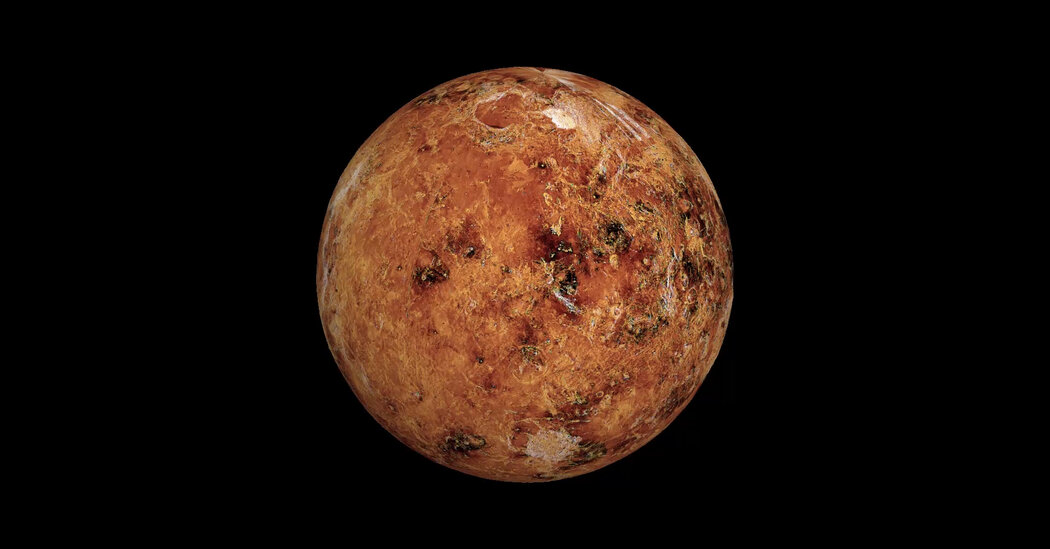Witnessing the blood-red fires of a volcanic eruption on Earth is unforgettable. But seeing molten rock bleeding from a volcano on another planet would be extraordinary. That’s close to what scientists have seen on Venus: two huge, wavy lava flows pouring out of two different corners of Earth’s planetary neighbor.
“After you see something like this, the first reaction is ‘wow,'” said Davide Sulcanese, a doctoral student at the Università d’Annunzio in Pescara, Italy, and author of a study reporting the discovery in the journal Nature Astronomy. published on Monday.
Earth and Venus were created at the same time. Both are made of the same primordial matter and both are the same age and size. So why is Earth a paradise teeming with water and life, while Venus is a scorched hell with an acidic sky?
Volcanic eruptions play with the planetary atmosphere. One theory holds that eons ago, several apocalyptic eruptions triggered a greenhouse effect on Venus, turning it from a temperate, waterlogged world into an arid desert of burnt glass.
To better understand its volcanism, scientists hoped to capture a Venus eruption. But although the planet is known to be choked with volcanoes, the opaque atmosphere prevented anyone from seeing the eruption the way the spacecraft did on Io, Jupiter’s hypervolcanic moon.
In the 1990s, NASA’s Magellan spacecraft used cloud-penetrating radar to survey most of the planet. But at the time, the relatively low-resolution images made observing fresh molten rock a difficult task.
Using modern software to examine Magellan’s data, scientists have now found two distinct lava flows: one tripped up the flank of Sif Mons, a broad shield volcano, and another that winds across the western part of Niobe Planitia, a flat plain dotted with numerous volcanic mountains.
Many planetary scientists believed that Venus was full of eruptions. “But it’s one thing to have a strong sense of it, and quite another to know it,” said Paul Byrne, a planetary scientist at the University of Washington in St. Louis, who was not part of the new study.
Venus lacks the plate tectonics of Earth. But its similarly rocky structure and comparable size suggest that something must still be brewing inside the second solar planet – and it should be volcanically active.
There is circumstantial supporting evidence: volcanic gases persist in the Venusian sky, and the way parts of the planet glow suggests they were coated with lava in the recent geologic past.
Direct evidence of volcanic fury finally and surprisingly emerged in 2023, when researchers spotted a volcanic vent that had doubled in size and possibly filled with lava in the old Magellan data. Other scientists still longed for signs of a definite lava flow, almost literally a smoking gun.
Mr. Sulcanese fulfilled their wishes. In later images of Magellan’s surveys, he found bright river-like spots on Sif Mons and Niobe Planitia that were not present in the earlier data. After carefully ruling out other possibilities, including landslides, his team concluded that lava was the only reasonable explanation.
“Magellan is the gift that keeps on giving,” said Stephen Kane, a planetary astrophysicist at the University of California, Riverside, who was not involved in the new study.
Both lava flows are comparable in size to the output of Hawaii’s Kilauea volcano during its three-month paroxysm in 2018. And using these two eruptions, the study authors estimate that there is significantly more eruptive activity than previously thought—and that it is occurring. elsewhere on the planet at present.
“Venus is active,” said Giuseppe Mitri, an astronomer also at the Università d’Annunzio and author of the study.
More importantly, in volcanic terms, Venus “is similar to Earth,” said Anna Gülcher, a planetary scientist at the Cal Institute of Technology who was not involved in the work.
The result also complicates the preliminary detection of phosphine in the atmosphere of Venus; phosphine is a substance that is usually associated with living things on Earth. But other explanations for its possible presence on Venus cannot be ruled out. Volcanic activity can also create phosphine, but refutations of this idea suggest that Venus simply does not have enough volcanism to create it.
“Well, apparently so,” said Dr. Buzzard.
The only way to find better answers—about phosphine, Venus’s volcanic cadence, its cataclysmic transformation—is to revisit the planet. Fortunately, a fleet of new starships in the 1930s is set to do just that.
While we wait, Magellan’s memories will continue to offer unexpected gifts.
“We can start thinking about Venus as a living, breathing world,” said Dr. Byrne.
